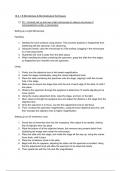Essay
Understand the importance of microbial classification to medicine and industry. Undertake microscopy for specimen examination in laboratories.
- Course
- Institution
A research report using any appropriate format that covers four of the listed microorganisms. Practical work setting up and using light microscopes and oil immersion lenses to look at the structure of microorganisms. Scientific drawings of specimens, laboratory notebooks and practical write-ups sup...
[Show more]



